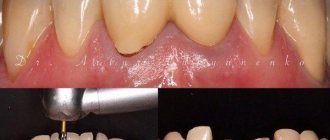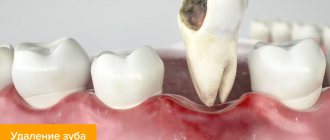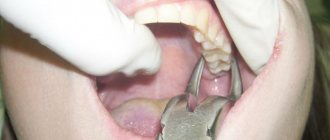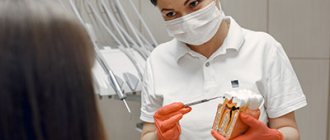Alveolar osteitis (alveolitis, fibrinolytic alveolitis, osteomyelitis, dry alveolus, thrombus infection, etc.) is an inflammation of the open area of the alveolar bone (alveolar process of the upper or lower jaw). It is a classic complication after surgery to remove a tooth(s). It usually occurs when, after surgery, a cavity or defect remains in the gum. This leads to the fact that the acidic environment of the oral cavity begins to affect bone tissue, causing alveolar osteitis.
A fragment remains after tooth extraction: why does this happen?
A tooth is an integral organ that consists of a crown and root parts. If a root or splinter remains after tooth extraction, it means the tooth has lost its integrity. This occurs due to mechanical stress during removal. Tooth destruction during extraction occurs for a number of reasons.
- Doctor's mistake.
Lack of doctor qualifications is a fairly common cause of complications. Incorrect tooth extraction technique can lead to the destruction of even a relatively strong tooth. - Poor condition of the tooth root.
If the root of the tooth remains in the gum, this is often due to the fact that the root part was in poor condition, so when you try to remove it, the tooth literally breaks into two parts. - When removing a tooth,
the neighboring one was hit, and a fragment from it fell into the socket. This happens quite rarely, but it still happens. This situation is also a consequence of incorrect extraction technique.
Treatment of alveolar osteitis
Prophylactic antibiotics reduce the risk of alveolar osteitis, as well as relieve pain and reduce the risk of soft tissue infections.
If we are talking about treatment, it is usually symptomatic (for example, taking painkillers), and the dentist also removes debris from the nest by irrigation with saline solution or local anesthesia. Medicinal solutions can be placed in the exposed socket, but their use is limited due to severe pain.
People who experience alveolar osteitis often seek help from a doctor several times after surgery.
Moscow metro station Zvezdnaya, Danube Avenue, 23
Symptoms
This complication has very pronounced symptoms.
- Pain.
Many people perceive pain as a standard consequence of tooth extraction. This is partly logical, but over time the pain does not stop and only gets stronger. This is a clear sign of a complication. - Swelling and inflammatory process.
A tooth fragment injures soft tissues, causing swelling and inflammation. The longer you delay treatment, the stronger the inflammation. - A characteristic coating in the area of the hole.
Appears at a later stage, when the body tries to fight the inflammatory process. - Pus and bad breath.
A late stage complication that requires immediate intervention.
What does it lead to?
Many patients believe that atrophy is a completely harmless consequence of tooth loss. After all, visually this problem almost does not manifest itself at all. But that's not true. As the bone subsides, aesthetic defects in appearance arise and disturbances in the functioning of internal organs occur.
The most common consequences of decreased jaw bone volume are:
- change in appearance - an asymmetrical oval of the face appears, lips and cheeks seem to fall inward;
- a large number of wrinkles form in a short period of time;
- diction changes - the person becomes “lisp”;
- diseases of the gastrointestinal tract occur (this is due to poor quality of chewing food, swallowing large pieces);
- changes in bite, displacement of teeth adjacent to the atrophied area;
- impossibility of implantation without prior bone grafting.
Complicating factors
The extraction procedure itself is ordinary and highly predictable, given the level of modern dentistry and the technological equipment of clinics. Nevertheless, even such manipulation has complications, especially if you take it lightly. It is worth taking into account that each clinical case is individual: if in one case tooth extraction is not very difficult, then in another the dental surgeon has to apply all his skills and use advanced technologies and equipment in treatment. It is no coincidence that the price lists of clinics include the item “Complicated tooth extraction”: you have to pay more for this service. Experts identify several factors that can lead to complications, including fragments in the socket.
- Wisdom teeth.
Because of their remoteness, default eights are quite difficult to remove. They often grow incorrectly or do not fully erupt, which increases the risk of complications during removal. - Retention.
A tooth that has not fully erupted, when only part of the crown is visible above the gum or is completely hidden in the soft tissues. - Dystopia.
The tooth erupts at the wrong degree and abuts its neighbors. - The tooth is severely damaged due to trauma.
In such a situation, when removed, it may crumble, and some of the fragments will remain in the hole.
How to avoid atrophy
It is much easier to avoid a problem than to look for ways to solve it later. The only way to prevent jaw atrophy is timely implantation. Under no circumstances should you walk around with an unsightly toothless smile for a long time.
If the bone begins to decrease due to periodontitis, severe thyroid disease, or hormonal imbalance, you should undergo proper treatment. At the same time, the patient needs to carefully monitor the health of his teeth and gums and unquestioningly follow all medical prescriptions.
A healthy and balanced diet is crucial in the prevention of atrophy. All people should eat fresh vegetables and fruits every day. While chewing them, the necessary load is created on the jaws, and the blood supply to the tooth roots increases.
What to do if the tooth is not completely removed?
If a piece of a tooth or part of a root remains after removal, and the doctor did not notice it, then sooner or later the symptoms described above will appear. What to do if a tooth is pulled out and a fragment remains? First of all, there is no need to panic. A regular x-ray can detect the presence of foreign bodies, including remaining fragments. In most cases, tooth removal does not take much time and is performed using standard surgical techniques. If the case is complex, an incision of the mucosa may be required. Today there are advanced surgical treatment techniques, such as laser surgery. Thanks to this, in difficult cases it is possible to reduce the invasiveness of the intervention. Be that as it may, for a qualified dentist, coping with the complication will not pose any great difficulties. The main thing is to contact him in time.
Many people are interested in whether the tooth root can come out on its own. If after removal part of the root remains in the gum, then you definitely shouldn’t count on it. Sometimes a tooth fragment may come out on its own, but there is no need to hope for this either. Moreover, you should not try to remove a tooth fragment from the socket yourself. You will most likely hurt yourself even more. If you notice remains of a tooth in the hole, go to the doctor immediately.
What is bone tissue?
This is the connective tissue of the jaw that performs a protective and supportive function. It is formed by two types of cells (osteoblasts and osteoclasts) and intercellular substance. The latter includes calcium chloride and fluoride, collagen fibers, due to which the bone becomes elastic and more elastic.
The functions of osteoblast cells are the production of collagen and calcium salts, osteoclasts are the destruction of bone and a decrease in its volume. Throughout life, creative processes in the jaw are replaced by destructive ones. While a person is young, this balance is maintained, but over the years, regenerative reactions become less active. As a result, after about 40 years, the influence of osteoclasts becomes more pronounced.
It is for this reason that if a tooth is pulled out from an adult, the gums will begin to sag quite soon. Without adequate chewing load, the bone will decrease in size. To restore the pressure necessary for full functioning of the jaw, it is necessary to undergo implantation or prosthetics.
Other situations
Sometimes after tooth extraction a phenomenon called ecostosis occurs. After tooth extraction, the edge of the gum settles, causing part of the bone to protrude to the surface. Many patients may mistake a piece of bone for a tooth fragment. Ecostosis can be easily eliminated using the usual grinding procedure, so there is practically nothing to worry about in this case. Sometimes part of the bone material may come out of the hole, which is replanted with the patient before implantation if the height and volume of the native bone is not enough. Sometimes small pieces of bone material may come out through the sutures, but this is also not considered a serious complication.
How to recover
Most often, to eliminate the effects of atrophy, dentists prescribe surgery. Medicines cannot correct the situation. They often turn out to be useless, even if they just need to slow down regression.
Among the most effective methods of returning the original volume of the bone structure:
- Sinus lift. Suitable for working on the upper jaw only. During the intervention, the surgeon raises the bottom of the maxillary sinus to the height required for implantation. He fills the resulting cavity with special shavings. After sinus lift, you can proceed to implantation.
- Osteoplasty. An operation to transplant a small area of donor/own material. If necessary, the doctor can use synthetic material. The technique is popular because it takes little time. At the same time, the risk of rejection of the transplanted area is minimal.
- Tissue regeneration. An innovative technique that involves growing new bone tissue directly in the patient’s mouth. To obtain the desired result, a special protective membrane is placed in the deformed area. It creates a space in which regenerative processes take place as actively as possible.
- Transplantation of the prepared block. Indicated if you need to restore a large atrophied area of the jaw. The doctor takes material for transplantation from the patient’s bone, obtained from the palate, beard. It is also possible to use donor blanks.
The specialist decides which of the available methods is suitable for a particular patient on a personal basis.
Bone regeneration before implantation
Dental implant placement has become a common practice in modern dentistry. But it is not uncommon for a doctor to puzzle a patient with an unexpected proposal to first go through the process of restoring jaw bone tissue. Do not be upset if you are one of those patients who cannot have an implant installed immediately without bone grafting. And in no case should you look for doctors who will agree to follow your impatience and not carry out restoration of the jaw bone tissue - in the end this will end in even bigger problems.











